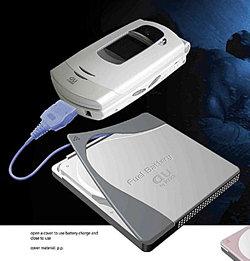Fuel-Cell-Powered Mobile Phones for Terrestrial Digital TV
13 August 2004 by axxxr Japanese mobile phone manufacturers to develop a fuel-cell-powered mobile phone equipped with functions for receiving terrestrial digital TV broadcasting.
In Japan, the terrestrial digital TV broadcasting is expected to be launched between December 2005 and February 2006. They aim to complete the development of the new fuel cell before the broadcasting service is commenced. Hitomi Murakami, KDDI's vice president and general manager of IT Development Division, and Norio Numata senior manager, Technology Development Dept, IT Development Division, jointly revealed the plan in a recent interview with Nikkei Nanotechnology. KDDI has signed joint development agreements with Toshiba Corp and Hitachi Ltd. Although the two manufacturers will develop fuel-cell-equipped mobile phones separately on the basis of their own technology, they will use the same user interface that includes the fuel inlet. KDDI is ready to collaborate with other companies as well in the development of the new fuel cell, Murakami said. He believes that the new fuel cell to be developed by the three firms has great potential to become a standard cell that can be incorporated in the cell phones designed for other mobile phone carriers' services. With this prospect, KDDI is apparently taking an ambitious stance with regard to the development of the new fuel cell. According to Murakami, KDDI is pushing forward with this plan because the company attaches importance to demands from users of its mobile phones. The result of a survey the company has conducted lately has found that an overwhelming majority of mobile phone users want the capability of receiving TV broadcasting to be incorporated into their handsets, Murakami said. The mobile phone carrier aims to meet the users' demand for the TV function, simultaneously with the launch of the terrestrial digital TV broadcasting service designed for highly efficient, high-performance mobile receivers. In order to put the new mobile phone into practical use, however, KDDI needs to resolve the issue involving the continuous operating time of the phone. At present, its maximum continuous operating time is only two hours. This can be attributed to the fact that the handset consumes much more power when showing TV programs than when it is in the stand-by mode. KDDI expects that the handset, which the company will release simultaneously with the launch of the terrestrial digital TV broadcasting service, consumes electricity of about 2mA when it is in the stand-by mode, and about 200mA when it is used as a mobile TV, Numata said. According to Murakami, there is a growing trend in which businesses and organizations use mobile phones in their operations. The Japanese Police, for example, are gradually replacing the traditional radio system with mobile phones, he said. Murakami reckons that the mobile phones' short continuous operating time may become an issue in the future. The only two-hour continuous operating time means that the users may not be able to use their mobile phones in an emergency, and this could discourage people from using mobile phones, he said. Taking these facts into account, KDDI has determined to extend the continuous operating time of its new mobile phone. To extend the continuous operating time, KDDI has decided to incorporate in its mobile phone the direct methanol fuel cell (DMFC), which has higher energy density than that of the Li-Ion cell. The incorporation of DMFC into the new mobile phone will allow its users to use the device without recharging. They can use the mobile phone continuously by refilling DMFC with methanol. KDDI plans to complete the joint development before the terrestrial digital TV broadcasting service begins two years from now. The three companies will develop the fuel-cell-equipped handset in stages. Initially, they will develop a fuel cell to be attached to the mobile phone externally as the first prototype by the end of 2004. Then in the next stage, they will develop a fuel-cell-embedded handset as the second prototype by the end of 2005. Currently, the three companies are trying to decide on the specifications for the externally-attached fuel cell.In order to secure electricity for the communication, they are considering of adopting a power supply system in which the externally-attached fuel cell, instead of the Li-Ion battery installed in the mobile phone, will supply electricity when the user watches TV on the mobile device, Murakami said. KDDI expects the output current and output voltage of the fuel cell to be 200mA and 4V respectively and the battery life, 10 hours, Numata said.
Via: neasia.nikkeibp.com
|











 RSS feed
RSS feed